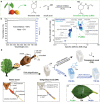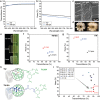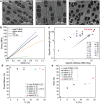High Performance, Fully Bio-Based, and Optically Transparent Wood Biocomposites
- PMID: 34194952
- PMCID: PMC8224414
- DOI: 10.1002/advs.202100559
High Performance, Fully Bio-Based, and Optically Transparent Wood Biocomposites
Abstract
The sustainable development of engineering biocomposites has been limited due to a lack of bio-based monomers combining favorable processing with high performance. Here, the authors report a novel and fully bio-based transparent wood biocomposite based on green synthesis of a new limonene acrylate monomer from renewable resources. The monomer is impregnated and readily polymerized in a delignified, succinylated wood substrate to form optically transparent biocomposites. The chemical structure of the limonene acrylate enables diffusion into the cell wall, and the polymer phase is both refractive index-matched and covalently linked to the wood substrate. This results in nanostructured biocomposites combining an excellent optical transmittance of 90% at 1.2 mm thickness and a remarkably low haze of 30%, with a high mechanical performance (strength 174 MPa, Young's modulus 17 GPa). Bio-based transparent wood holds great potential towards the development of sustainable wood nanotechnologies for structural applications, where transparency and mechanical performance are combined.
Keywords: biocomposite; bio‐based polymers; nanotechnology; sustainable; transparent wood.
© 2021 The Authors. Advanced Science published by Wiley‐VCH GmbH.
Conflict of interest statement
The authors declare no conflict of interest.
Figures





Similar articles
-
Sustainable Thermal Energy Batteries from Fully Bio-Based Transparent Wood.Small. 2023 Jul;19(28):e2301262. doi: 10.1002/smll.202301262. Epub 2023 Mar 27. Small. 2023. PMID: 36970834
-
High-Density Molded Cellulose Fibers and Transparent Biocomposites Based on Oriented Holocellulose.ACS Appl Mater Interfaces. 2019 Mar 13;11(10):10310-10319. doi: 10.1021/acsami.8b22134. Epub 2019 Feb 27. ACS Appl Mater Interfaces. 2019. PMID: 30762342
-
Effect of Wood Species on Lignin-Retaining High-Transmittance Transparent Wood Biocomposites.Polymers (Basel). 2024 Aug 31;16(17):2493. doi: 10.3390/polym16172493. Polymers (Basel). 2024. PMID: 39274125 Free PMC article.
-
A comprehensive review of the synthesis strategies, properties, and applications of transparent wood as a renewable and sustainable resource.Sci Total Environ. 2023 Mar 15;864:161067. doi: 10.1016/j.scitotenv.2022.161067. Epub 2022 Dec 22. Sci Total Environ. 2023. PMID: 36565890 Review.
-
Transparent Wood Fabrication and Applications: A Review.Molecules. 2025 Mar 28;30(7):1506. doi: 10.3390/molecules30071506. Molecules. 2025. PMID: 40286115 Free PMC article. Review.
Cited by
-
Wood and Cellulose: the Most Sustainable Advanced Materials for Past, Present, and Future Civilizations.Adv Mater. 2025 Jun;37(22):e2415787. doi: 10.1002/adma.202415787. Epub 2025 Jan 7. Adv Mater. 2025. PMID: 39777803 Free PMC article.
-
Translucent Biocomposites from Hot-Pressed Wood Fibers and Poly(limonene acrylate).ACS Appl Mater Interfaces. 2025 Jul 30;17(30):43522-43535. doi: 10.1021/acsami.5c07130. Epub 2025 Jul 21. ACS Appl Mater Interfaces. 2025. PMID: 40686486 Free PMC article.
-
Wood xerogel for fabrication of high-performance transparent wood.Nat Commun. 2023 May 17;14(1):2827. doi: 10.1038/s41467-023-38481-x. Nat Commun. 2023. PMID: 37198187 Free PMC article.
-
Sustainable Wood Nanotechnologies for Wood Composites Processed by In-Situ Polymerization.Front Chem. 2021 Jul 1;9:682883. doi: 10.3389/fchem.2021.682883. eCollection 2021. Front Chem. 2021. PMID: 34277566 Free PMC article.
-
Wood-Derived Hydrogels for Osteochondral Defect Repair.ACS Nano. 2025 Jan 14;19(1):520-534. doi: 10.1021/acsnano.4c10430. Epub 2024 Dec 27. ACS Nano. 2025. PMID: 39730305 Free PMC article.
References
-
- Evans P., Matsunaga H., Kiguchi M., Nat. Nanotechnol. 2008, 3, 577. - PubMed
-
- Li Y., Vasileva E., Sychugov I., Popov S., Berglund L., Adv. Opt. Mater. 2018, 6, 1800059.
-
- Jiang F., Li T., Li Y., Zhang Y., Gong A., Dai J., Hitz E., Luo W., Hu L., Adv. Mater. 2018, 30, 1703453. - PubMed
-
- Berglund L. A., Burgert I., Adv. Mater. 2018, 30, 1704285. - PubMed
-
- Li Y., Fu Q., Yu S., Yan M., Berglund L., Biomacromolecules 2016, 17, 1358. - PubMed
Publication types
LinkOut - more resources
Full Text Sources
